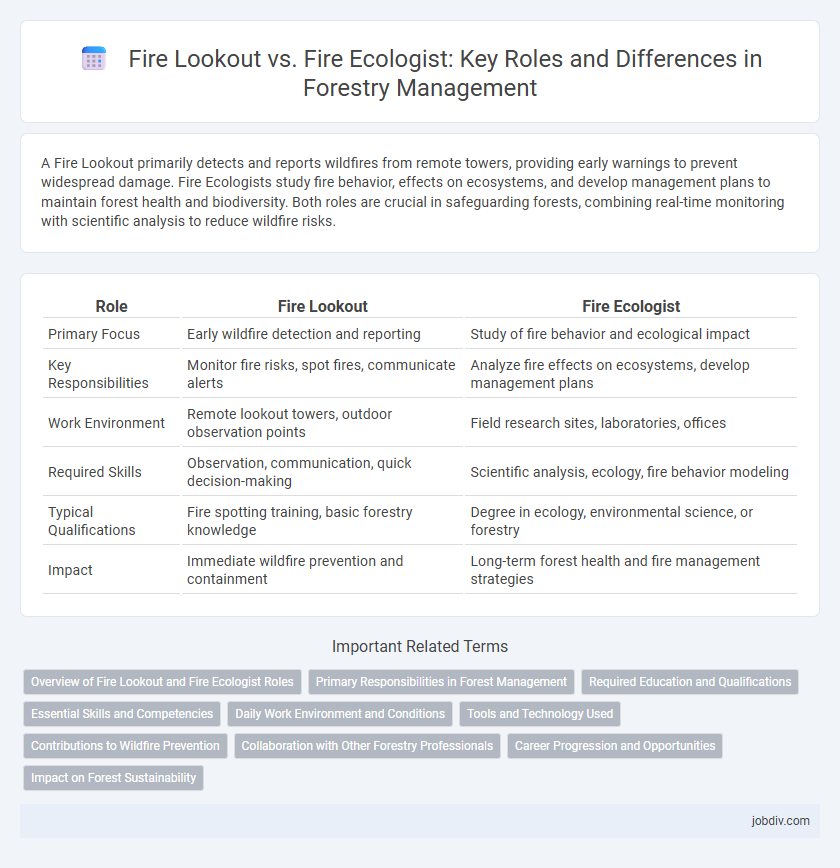A Fire Lookout primarily detects and reports wildfires from remote towers, providing early warnings to prevent widespread damage. Fire Ecologists study fire behavior, effects on ecosystems, and develop management plans to maintain forest health and biodiversity. Both roles are crucial in safeguarding forests, combining real-time monitoring with scientific analysis to reduce wildfire risks.
Table of Comparison
| Role | Fire Lookout | Fire Ecologist |
|---|---|---|
| Primary Focus | Early wildfire detection and reporting | Study of fire behavior and ecological impact |
| Key Responsibilities | Monitor fire risks, spot fires, communicate alerts | Analyze fire effects on ecosystems, develop management plans |
| Work Environment | Remote lookout towers, outdoor observation points | Field research sites, laboratories, offices |
| Required Skills | Observation, communication, quick decision-making | Scientific analysis, ecology, fire behavior modeling |
| Typical Qualifications | Fire spotting training, basic forestry knowledge | Degree in ecology, environmental science, or forestry |
| Impact | Immediate wildfire prevention and containment | Long-term forest health and fire management strategies |
Overview of Fire Lookout and Fire Ecologist Roles
Fire Lookouts serve as the frontline observers in forestry management, stationed in elevated towers to detect and report wildfires early, ensuring rapid response and containment. Fire Ecologists analyze fire behavior, ecological impacts, and the role of fire in ecosystem dynamics to inform sustainable forest management and prescribed burning practices. Together, these roles contribute to comprehensive wildfire detection, mitigation, and ecological balance within forested landscapes.
Primary Responsibilities in Forest Management
Fire Lookouts are primarily responsible for early detection of wildfires, monitoring remote forest areas to report smoke or fire activity promptly. Fire Ecologists conduct research on fire behavior, ecosystem impacts, and develop fire management strategies to maintain forest health and biodiversity. Both roles are crucial in forest management, combining real-time observation and scientific analysis to mitigate wildfire risks and promote sustainable forest ecosystems.
Required Education and Qualifications
Fire Lookouts typically require a high school diploma or equivalent, with on-the-job training for fire detection and communication skills, while Fire Ecologists often hold advanced degrees in ecology, forestry, or environmental science, emphasizing research, data analysis, and fire behavior understanding. Certifications such as Wildland Firefighter Type 2 (FFT2) are valuable for Fire Lookouts, whereas Fire Ecologists benefit from credentials like Certified Forester (CF) or memberships in professional ecological societies. The educational pathway for Fire Ecologists involves rigorous coursework and fieldwork to study fire ecology, contrasting with the more operational and observational role of Fire Lookouts.
Essential Skills and Competencies
Fire Lookouts require keen observational skills, strong communication abilities, and proficiency in using spotting equipment to detect and report wildfires promptly. Fire Ecologists need expertise in fire behavior, ecosystem management, and data analysis to assess fire impacts and develop fire management strategies. Both roles demand physical endurance and knowledge of fire safety protocols, but Fire Ecologists emphasize scientific research and ecological restoration competencies.
Daily Work Environment and Conditions
Fire Lookouts work in isolated towers, often positioned on remote ridges or high vantage points, spending long hours monitoring vast forest areas for early signs of wildfires under varying weather conditions. Fire Ecologists operate primarily in the field and laboratories, conducting ecological assessments and research on fire behavior, vegetation, and soil, frequently navigating challenging terrains and adapting to fluctuating environmental factors. Both roles require resilience to outdoor elements but differ significantly in their interaction with nature and scientific analysis settings.
Tools and Technology Used
Fire lookouts primarily utilize remote sensing tools such as high-powered binoculars, digital cameras, and radio communication systems to detect and report wildfires from observation towers. Fire ecologists employ advanced technologies including GIS mapping, satellite imagery, and soil moisture sensors to study fire behavior, assess ecological impacts, and develop fire management strategies. Both roles integrate weather monitoring instruments and data analytics software to enhance fire detection, prediction, and ecosystem recovery efforts.
Contributions to Wildfire Prevention
Fire lookouts provide early detection of wildfires by continuously monitoring forested areas from elevated towers, enabling rapid response and containment efforts. Fire ecologists study fire behavior, effects on ecosystems, and develop management strategies that promote natural fire regimes and reduce fuel loads. Together, their contributions enhance wildfire prevention through timely alerts and scientifically informed landscape management.
Collaboration with Other Forestry Professionals
Fire lookouts and fire ecologists collaborate closely with forestry professionals to monitor wildfire risks and develop effective management strategies. Fire lookouts provide real-time observation data that helps ecologists analyze fire behavior and assess ecosystem health for informed decision-making. This synergy enhances wildfire prevention, promotes forest resilience, and supports sustainable forestry practices.
Career Progression and Opportunities
Fire Lookouts primarily start in entry-level roles monitoring forest conditions and reporting fire activity, gaining field experience before advancing to positions like Fire Dispatcher or Fire Management Officer. Fire Ecologists often require advanced education in environmental science or ecology, leading to research and policymaking roles that influence forest management strategies. Career progression for Fire Ecologists typically includes opportunities in academic research, governmental agencies, and consultancy, providing a broader scope of influence compared to the operational focus of Fire Lookouts.
Impact on Forest Sustainability
Fire lookouts provide critical early detection of wildfires, enabling rapid response to prevent extensive forest damage. Fire ecologists analyze fire behavior and its ecological role, promoting sustainable forest management through controlled burns and habitat restoration. Integrating both roles enhances forest sustainability by balancing fire prevention with ecological resilience.
Fire Lookout vs Fire Ecologist Infographic

 jobdiv.com
jobdiv.com